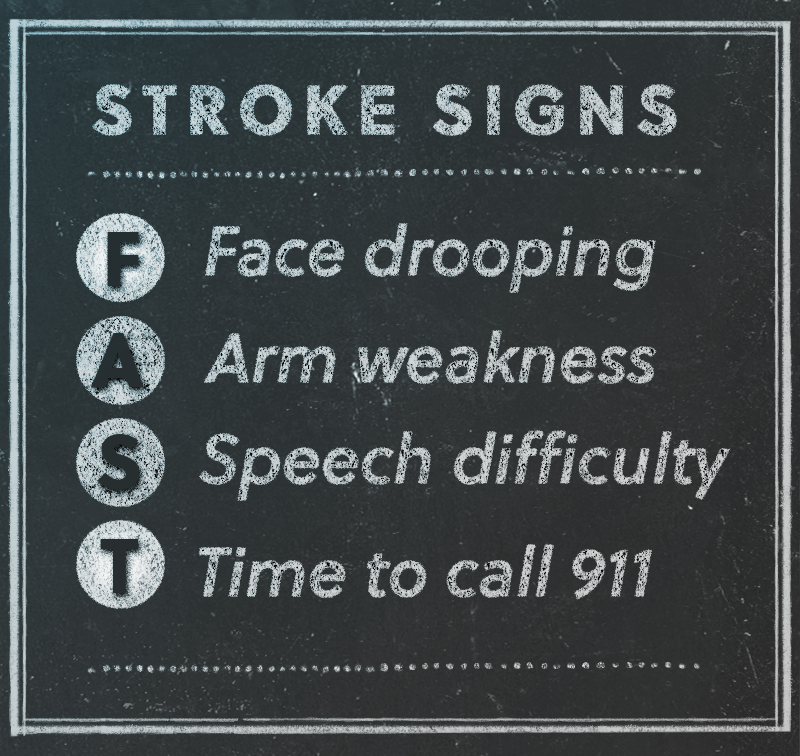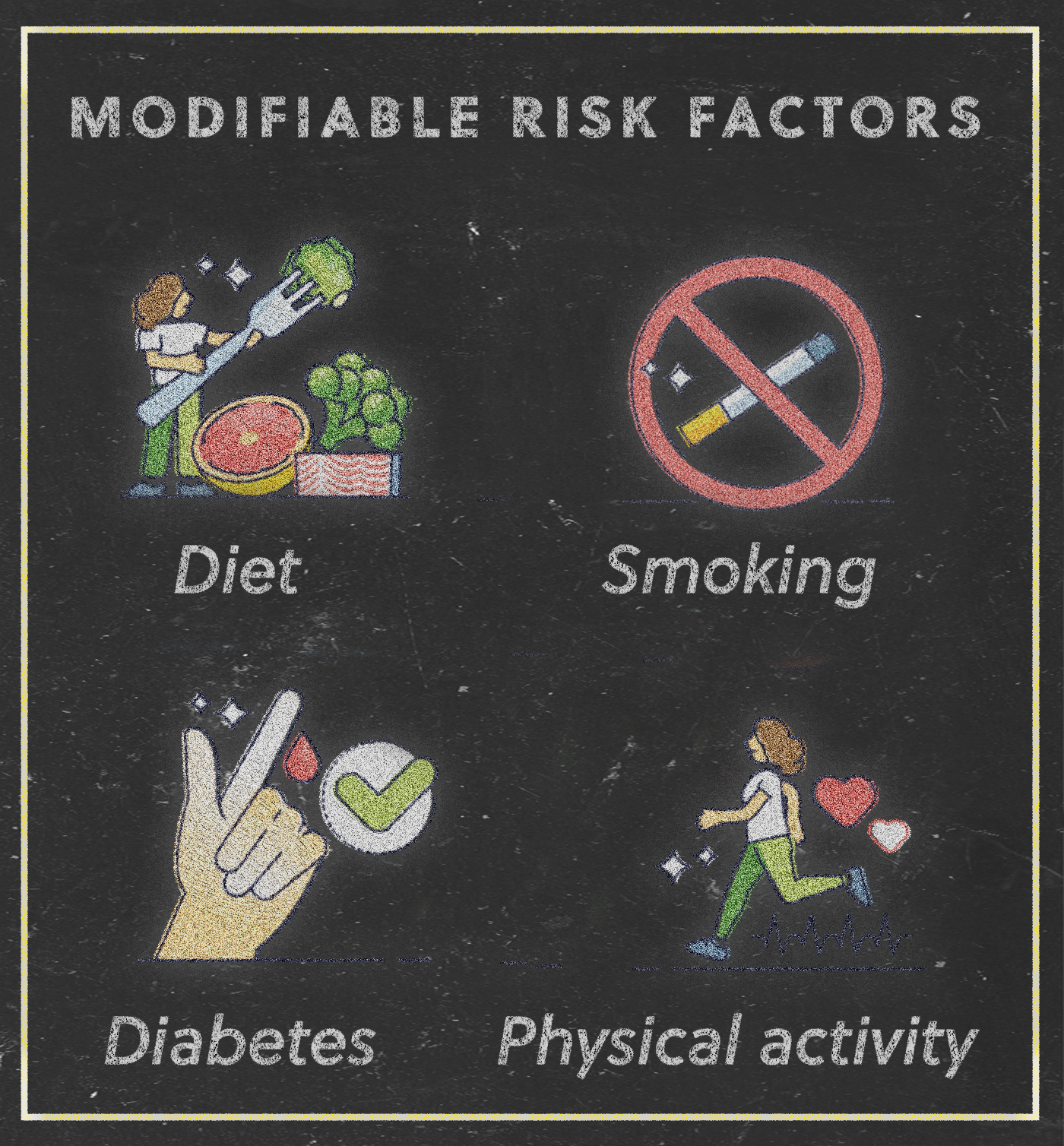What is Stroke?
A stroke occurs when a blood vessel that brings blood to the brain gets blocked or ruptures. When this occurs, the brain is unable to get enough oxygen, causing your brain cells to no longer be able to properly function.
Your brain is responsible for your ability to move, feel, think and behave. Therefore, a stroke can affect any of these aspects of one’s life. Stroke is the 5th leading cause of death and the leading cause of disability in America. For this stroke awareness month, we want to teach you what to look for when someone is having a stroke as well as what may increase your risk of a stroke.
Stroke Symptoms
The best way to tell is someone is suffering a stroke is to use the acronym F.A.S.T.
- F Face drooping
Does one side of the face feel numb or look droopy? Ask the person to smile, is the smile uneven? - A Arm weakness
Is one arm weak or numb feeling? Ask the person to raise both arms. Does one arm slowly drift downward? - S Speech difficulty
Does the persons speech sound slurred? - T Time to call 9-1-1

A stroke can also present as other symptoms which include:
- Numbness or weakness of the face, arms or legs, especially on one side of the body
- Confusion, trouble speaking or understanding speech
- Trouble seeing in one or both eyes
- Trouble walking, dizziness, loss of balance or coordination
- Severe headache with no known cause
Stroke symptoms in men vs. women
Men and women generally present similar stroke symptoms. That being said, women often report additional symptoms compared to men including:
- Trouble breathing
- Fainting and/or loss of consciousness
- Hallucinations
- Hiccups
- Seizures
- Sudden behavioral changes and/or agitation
Stroke risk factors
Some risk factors for stroke are in your control (modifiable risk factors), whereas others are not (non-modifiable risk factors).
Modifiable risk factors for stroke
These are some risk factors that you can modify to reduce your risk of having a stroke:
- Smoking:
The nicotine and carbon monoxide contained within cigarette smoke does severe damage to the cardiovascular system which helps pave the way for a stroke. The combination of birth control pills and cigarette smoke greatly increases your risk a stroke. - Diabetes:
If you have diabetes, controlling your blood sugar levels is critical. Many people with diabetes also have high blood pressure, high cholesterol levels and are overweight, all of which are major contributors to having a stroke. - Diet:
Eating foods high in saturated fat, trans fats, calories and sodium can increase your risk of developing high blood pressure, high cholesterol levels and cause weight gain. But a diet containing at least five servings of fruits and vegetables daily can reduce your risk of stroke. - Physical inactivity:
Being inactive can increase your risk of developing many factors involved in stroke. It is recommended to be active for at least 150 minutes per week, but something as simple as moving more and sitting less can improve your stroke risk.

Non-modifiable risk factors for stroke
These are some risk factors that are out of one’s control when it comes to stroke risk:
- Age:
As your age increases, so does your risk of having a stroke. They are more common in the people 65 years of age or older, strokes can occur in people of any age. - Family history:
If a close family member such as parents, grandparents or siblings, have had a stroke before the age of 65, you may be at a greater risk of also having a stroke. - Race:
African-Americans are more likely to die from a stroke compared to Caucasians. This is partly due to the fact that African-Americans have a higher risk of high blood pressure, diabetes and obesity. - Gender:
Women tend to have strokes at older ages than men. Additionally, women have more strokes than men, and strokes are more likely to be fatal in women. Possible factors that may contribute to this increased risk in women is pregnancy, history of preeclampsia, use of birth control pills and post-menopausal hormone therapy. - Prior stroke or heart attack:
Someone who has already suffered a stroke has a much higher chance of having another one. In fact, 1 in 4 stroke survivors have another stroke within 5 years.
Women are at a higher risk of stroke than men
This is due to many factors including:
- Postmenopausal changes
- Preeclampsia/eclampsia—can nearly double a woman’s risk of having a stroke
- Migraines with Auras—can nearly double a women’s risk of having a stroke
- Atrial fibrillation (AFib)—more common in women and increases the risk of one developing a stroke by 5 times
- Women tend to have higher rates of aneurysms and subarachnoid hemorrhages than men
Stroke treatment
The treatment plan for a stroke depends on the type of stroke you are having. If you are having an ischemic stroke, caused by a blood clot, and you arrive at the hospital in time, you may be able to get a thrombolytic medication called tissue plasminogen activator (tPA) which helps break up the clot that is causing the stroke. If the stroke was the cause of an aneurysm rupture or brain bleed, the treatment plan will be much different and may require surgery in some cases.
Regardless, the most important things to remember if F.A.S.T.
A stroke is very time sensitive and the longer it goes untreated, the more damage it can do to your brain. That is why if you notice someone is having a stroke, call 9-1-1 immediately. The paramedics can provide initial care that is crucial to start treating this life-threatening event. As soon as you get to the hospital the emergency team will run numerous scans of the brain so they can figure out where you are having a stroke, what type of stroke you had, and how best to proceed forward.
Recovery from a stroke
Like all medical ailments, everyone’s recovery and treatment plan will be different. The type of stroke that occurred, where the stroke occurred in your brain, the length of time it went untreated, and the amount of damage that occurred will dictate what rehab is needed.
The brain is an amazing organ and is capable of tremendous recovery after a stroke. Some people will recover fully from a stroke whereas others may not fully recovery.
Once you’ve been cleared by your healthcare team rehabilitation will begin as soon as possible. Rehab can help ease the transition from the hospital to the home and can also help prevent another stroke from occurring.
Summary
Stroke is the 5th leading cause of death and the leading cause of disability in America. Although some risk factors are out of your control, many others such as smoking, diet and exercise can be controlled to minimize your risk.
Data informed by:
(1) American Stroke Association
(2) CDC: Stroke